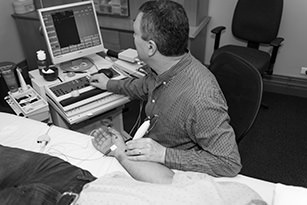EMG Test
What is an EMG?
An EMG (electromyogram) can be helpful in evaluating weakness, numbness, pain and symptoms such as fatigue, cramps and abnormal sensation.

The test is “an extension of the clinical examination” and your referring doctor will have asked a question on the referral for Dr Silbert to answer by doing the test. For example, a common question is “? cts” or in other words, is there any evidence on the test for the condition known as carpal tunnel syndrome which is a common cause of numbness or pain in the hands.
The analysis of the data occurs after you leave, but your presence for the test can vary from 10 – 30 minutes, depending upon the complexity of the clinical question asked by the referring. An essential part of the test is the preparation of the arm or leg, with warming in soapy water to set the temperature and remove skin oils and cells that interfere with the highly sensitive measurements. Sometimes only the first part of the test with nerve conduction studies are needed, but for other clinical questions the needle examination or examination of other limbs may be needed. Further analysis of the results is performed by Dr Silbert after the test, and the results are then reported in a format that your doctor can interpret and incorporate in to your clinical management.
Nerve Conduction Studies (NCS):
The measurements taken during the tests are very precise with time variables measured in milliseconds (0.001 seconds or 1 thousandth of a second) and the size of the response measured in milliVolts (1 thousandth of a volt) or microVolts (1 millionth of a volt) . To be accurate, it is necessary to warm the hand or foot to a standard temperature. If the limb is cold, then it alters the readings.
For this test, Dr Silbert tapes small discs on the skin and applies a brief electrical stimulus to the nerve, causing a tingling sensation. The electrical response of the nerve or muscle can determine if the nerve impulse travels normally (a healthy nerve), or abnormally (an abnormal or damaged nerve).
A healthy motor nerve in the arm sends signals which travel at more than 48 metres per second! A small delay can show the doctor where the nerve has a problem.
Electromyogram (EMG):
To understand more about the nerve and muscle function, the doctor analyses the electric activity in the muscles by inserting a fine needle electrode. Any discomfort felt is only mild. The needles are sterile and are thrown away after each patient.
Dr Silbert can determine whether the muscle is working normally by seeing the electrical activity on a screen and listening over a loud-speaker. Dr Silbert will decide whether the needle examination is required based upon the questions raised by the referring doctor, and the findings on the nerve conduction study part of the test.
Preparation for the test:
You should keep the skin free of any lotions or creams on the day of examination.
If you are taking Warfarin, or any other blood thinners you should tell the doctor before the test. The test can still be performed but Dr Silbert may modify the approach.
Results:
The results will be analysed after you leave and a report is then sent to your doctor, who will discuss the results with you.

